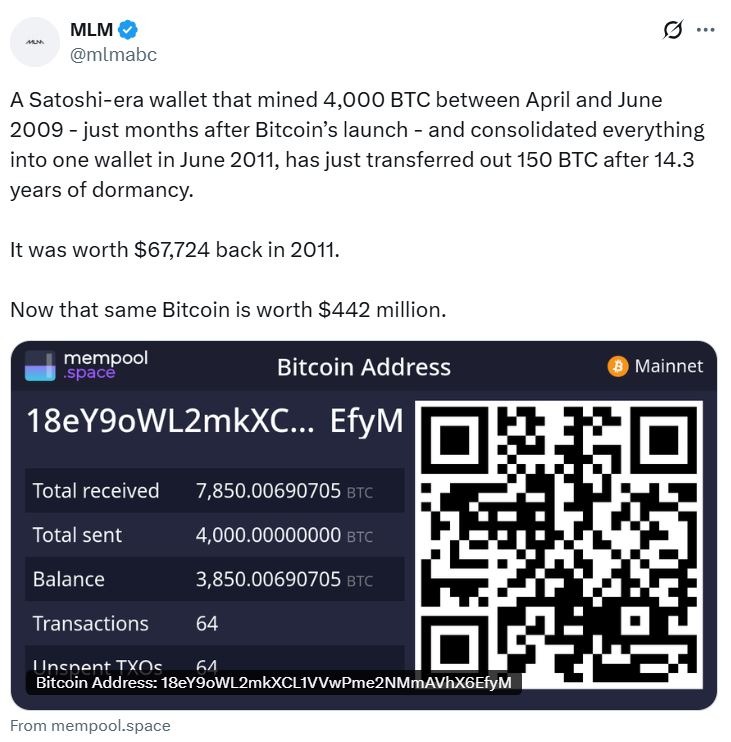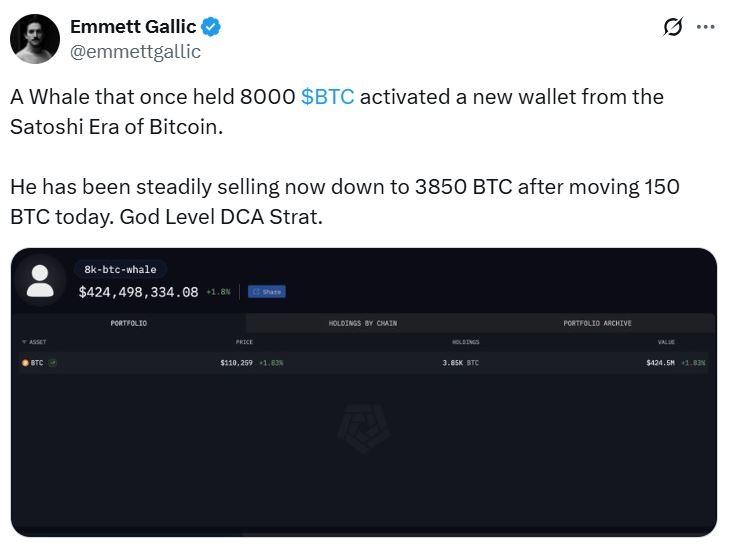A Satoshi-era Bitcoin whale, dormant since 2011, recently transferred 150 BTC worth over $16 million from a wallet holding 4,000 BTC mined in 2009. This movement highlights ongoing activity among early Bitcoin holders as prices reach $110,604, valuing the stash at $442 million.
-
Satoshi-era Bitcoin whale activates after 14 years: The wallet, last active in June 2011, sent funds for the first time since then.
-
Key transfer details: 150 Bitcoin moved on Thursday, valued at more than $16 million based on current market prices.
-
Historical context and value: Originally mined 4,000 BTC shortly after Bitcoin’s launch; total holdings once reached 7,850 BTC, now worth $442 million at $110,604 per BTC.
Discover the latest Satoshi-era Bitcoin whale movement: A dormant wallet awakens with a $16M transfer after 14 years. Explore implications for BTC holders and market trends today.
What is a Satoshi-era Bitcoin Whale and Why Does Its Movement Matter?
Satoshi-era Bitcoin whales refer to early holders of Bitcoin who accumulated large amounts of the cryptocurrency during its inception around 2009, named after Bitcoin’s pseudonymous creator, Satoshi Nakamoto. These entities, often wallets from the network’s first days, represent foundational stakes in the asset. The recent activation of one such whale, transferring 150 BTC after 14 years of dormancy, underscores the enduring influence of these original participants in today’s market, potentially signaling shifts in long-term holder behavior as Bitcoin’s value surges.
How Has This Satoshi-era Bitcoin Whale’s Activity Evolved Over Time?
The wallet in question was initially active between April and June 2009, mining approximately 4,000 Bitcoin just months after the Bitcoin network launched in January of that year. On-chain data indicates it once controlled up to 7,850 BTC across multiple addresses, with the last significant activity occurring in June 2011 when funds were consolidated. Blockchain analytics from platforms like Nansen reveal that on Thursday, the whale executed a single transaction moving 150 BTC, valued at over $16 million, marking its first movement in 14 years. This pattern aligns with broader trends among early adopters, where dormant wallets periodically reactivate amid rising prices.

Source: MLM
At a current trading price of roughly $110,604 per Bitcoin on Friday, the remaining balance in this wallet is now valued at over $442 million—a stark contrast to its worth of about $194 in 2010, when comprehensive price tracking began in July of that year. Such valuations highlight Bitcoin’s remarkable appreciation, turning early mining efforts into substantial fortunes. Experts note that these movements can influence market sentiment, though they often represent routine portfolio management rather than mass sell-offs.
Blockchain analyst Emmett Gallic, a self-employed researcher in the space, observed that the whale may have held as many as 8,000 BTC initially and has been gradually reducing its positions over years through separate addresses. In his analysis shared on X, Gallic described the strategy as a “God Level DCA Strat,” referring to dollar-cost averaging in reverse by steadily selling amid price appreciation. Current on-chain records from memepool space confirm the address has received a total of 7,850 BTC, with the balance now at 3,850 BTC following the recent 150 BTC transfer.

Source: Emmett Gallic
This incremental approach demonstrates sophisticated risk management among veteran holders, balancing liquidity needs with long-term retention. Nansen’s on-chain metrics further support that the transaction was isolated, with no immediate signs of broader liquidation.
Frequently Asked Questions
What Triggered the Recent Movement of This Satoshi-era Bitcoin Whale?
In a market where Bitcoin prices have climbed significantly, early holders like this Satoshi-era whale often reactivate to reallocate assets, secure funds, or capitalize on gains without fully exiting positions. Data from Whale Alert indicates the transfer occurred on Thursday, moving 150 BTC to an unknown destination, potentially for consolidation or exchange purposes, though no panic selling is evident.
Are Satoshi-era Bitcoin Whale Movements a Sign of Market Instability?
Voice search queries often ask about the impact of whale activity on Bitcoin’s stability, and the answer is that while these events draw attention, they typically reflect individual strategies rather than systemic issues. Analysts, including those from on-chain platforms, emphasize that new institutional buyers offset any sales from original holders, fostering market maturity and resilience.
Key Takeaways
- Satoshi-era Bitcoin whales remain influential: Dormant since 2011, this wallet’s $16 million transfer after 14 years shows early holders are still active participants in the ecosystem.
- Historical value explosion: Mined at negligible cost in 2009, the 4,000 BTC stash now exceeds $442 million, illustrating Bitcoin’s growth from $194 in 2010 to $110,604 today.
- Monitor for broader trends: Similar awakenings, like the July transfer of 80,201 BTC to Galaxy Digital, suggest ongoing portfolio adjustments—stay informed on whale alerts for market insights.
Conclusion
This awakening of a Satoshi-era Bitcoin whale serves as a reminder of Bitcoin’s deep roots and the strategic patience of its earliest proponents. With movements like the recent 150 BTC transfer and historical consolidations, these original holders continue to shape perceptions of Bitcoin whale activity. As the market evolves with institutional adoption, such events highlight a maturing asset class; investors should view them as opportunities to assess long-term trends rather than causes for alarm, positioning themselves for sustained growth in the cryptocurrency landscape.





